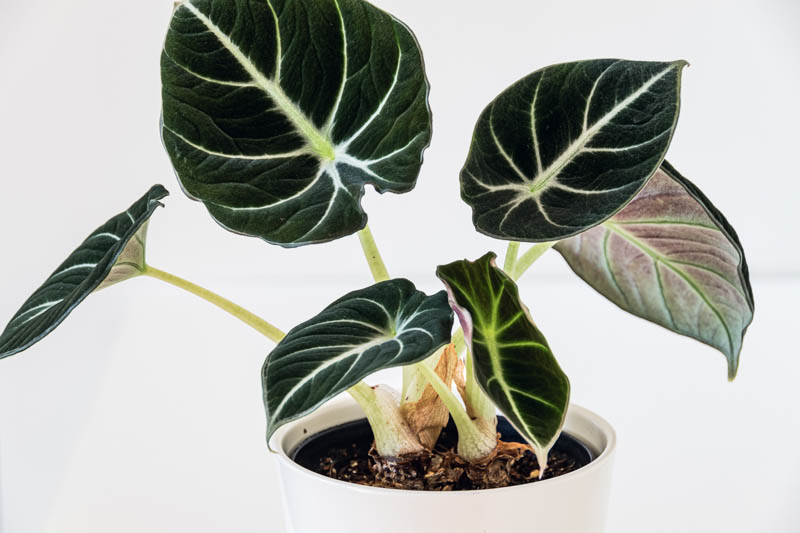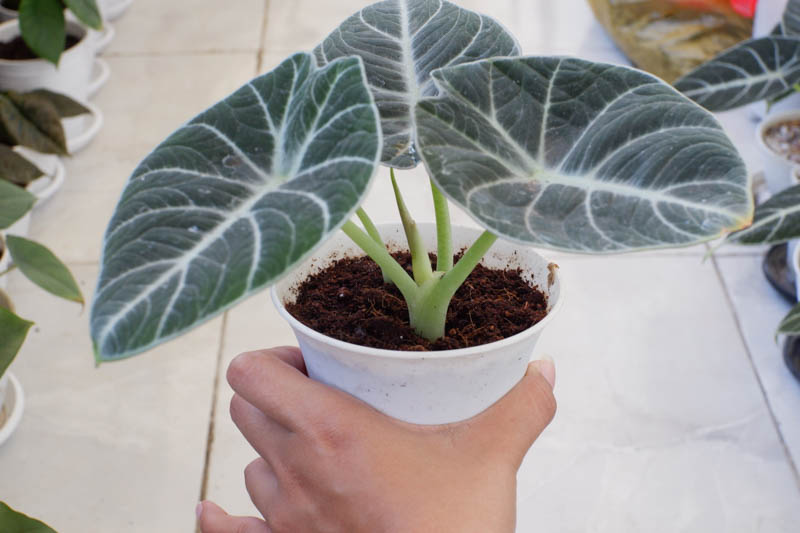Black Velvet Alocasia, Black Velvet Elephant Ear, Alocasia reginula
Alocasia reginula, known as Alocasia Black Velvet, is a captivating plant cherished for its luxurious, velvety leaves that contrast dramatically with bright, veined patterns. This jewel Alocasia, smaller than its giant relatives, offers a unique aesthetic to indoor plant collections and shaded garden spaces.
Alocasia Black Velvet presents dark, almost black leaves that are thick, velvety, and heart-shaped, with striking white or silver veins. Its compact size and dramatic coloring make it a popular choice for those looking to add a touch of the exotic to their indoor or outdoor plant collections.
Native: Alocasia reginula is native to Southeast Asia, where it grows in warm, humid, tropical environments. This understorey plant thrives in the dappled light of rainforest habitats. Alocasia Black Velvet belongs to the Araceae family, commonly known as the Arum family. This diverse family includes other well-known plants like Zantedeschia (Calla Lily), Caladium (Angel Wing), and Monstera (Swiss Cheese Plant).
Plant Type and Habit: It is a slow-growing, evergreen rhizomatous perennial known for its clump-forming habit and compact growth, making it suitable for indoor environments or shaded garden areas.
Size: Alocasia Black Velvet typically grows to about 12-18 inches (30-45 cm) in height and spread, making it an ideal houseplant or understory plant in tropical-themed gardens.
Flower: While it can flower, producing a spadix surrounded by a pale spathe, the blooms are infrequent and not the main attraction. The plant is grown primarily for its stunning foliage.
Foliage: The plant’s velvety, dark leaves are its standout feature, growing up to 8 inches (20 cm) long. They are deeply contrasted with bright veins, adding to its ornamental appeal.
Hardiness: If planted outdoors, Alocasia Black Velvet is suitable for USDA hardiness zones 10-11. It requires protection from cold and is often grown as a houseplant in cooler climates.
Uses: Primarily used as an ornamental plant, it’s perfect for adding texture and color contrast to indoor spaces. It can also be used in shaded outdoor gardens in warm climates or as a seasonal accent in cooler regions.
Toxicity: Alocasia plants are toxic if ingested. They contain calcium oxalate crystals that can cause irritation of the mouth, throat, and stomach in humans and pets.
Benefits: Like many houseplants, it can help improve indoor air quality by filtering airborne toxins.

Caring for Alocasia Black Velvet involves creating an environment that mimics their native tropical habitat.
Light: Indoors, Alocasia plants flourish in bright, indirect light, which supports vibrant foliage and growth. While they can adapt to lower light conditions, their health and appearance may be compromised, leading to slower growth and less pronounced leaf coloration. Ideally, they should be placed near east-facing windows where they receive gentle morning sunlight or in a well-lit room with ample ambient light. For low-light situations, supplemental artificial lighting may help maintain their health and vibrancy.
Outdoors, Alocasia can manage full sun conditions, particularly if it’s provided with enough water to keep the soil consistently moist. However, in areas with intense midday sun or during hot summer months, it’s advisable to position Alocasia in a location where it can receive partial shade or filtered sunlight, especially during the hottest parts of the day. Morning sun followed by afternoon shade is ideal to prevent leaf scorch while ensuring the plant receives enough light for healthy growth.
Soil: Indoors, Alocasia thrives in a well-draining, airy potting mix rich in organic matter. Use a blend of peat, perlite, and pine bark for optimal moisture retention and drainage. A slightly acidic to neutral pH supports healthy root growth, ensuring vibrant foliage indoors.
Outdoors, Alocasia prefers moist, fertile soil with good drainage. Incorporate compost or well-rotted manure into the planting area to enrich the soil and improve structure. A slightly acidic to neutral pH is ideal, allowing these tropical plants to absorb nutrients efficiently and flourish in garden settings.
Water: Keep the soil consistently moist but not waterlogged. Water when the top inch of soil feels dry to the touch. Overwatering can lead to root rot, so ensure good drainage.
Temperature and Humidity: Alocasia thrives in warm conditions, preferring temperatures between 65°F to 85°F (18°C to 29°C). Protect it from drafts and sudden temperature changes. Alocasia struggles in temperatures below 60°F (15°C), with some types dying back in cold conditions, only to regrow from the rhizome when it warms.
These plants love high humidity. Mist the leaves regularly, use a humidifier, or place the pot on a tray filled with pebbles and water to increase ambient humidity around the plant.
Fertilization: Feed your Alocasia with a balanced liquid fertilizer diluted to half-strength every 4-6 weeks during the growing season. Reduce fertilization in winter when growth slows.
Pruning: Prune away any yellowing or damaged leaves at their base to encourage new growth and maintain a tidy appearance.
Repotting: Repot in the spring every 2-3 years or when the plant becomes root-bound. Choose a pot only slightly larger than the current one to avoid oversaturating the soil.

Propagating Alocasia plants is typically done through division or by separating offsets, as most Alocasia species do not produce seeds readily, especially when grown as houseplants.
Choose the Right Time: Propagation is best done in the spring or early summer when the plant enters its active growth period.
Prepare Your Materials: Gather a sharp, clean knife or garden shears, pots filled with a suitable potting mix, and gloves to protect your hands from the plant’s sap, which can irritate some people.
Unpot and Inspect the Plant: Carefully remove the Alocasia from its pot and gently shake off the excess soil to expose the roots and rhizomes.
Divide the Plant: Look for natural divisions where the plant has produced offsets or where the rhizome can be easily separated. Cut through the rhizome to separate the divisions using the knife or shears, ensuring each division has at least one growth point (leaf or bud) and a portion of the root system.
Pot Up the Divisions: Plant each division in its own pot filled with a well-draining, airy potting mix similar to what the parent plant was growing in. Water lightly to settle the soil around the roots.
Care After Propagation: Place the newly potted divisions in a warm, bright location with indirect light. Keep the soil consistently moist but not waterlogged. High humidity can help the divisions recover and grow more vigorously, so consider placing them in a more humid room or using a humidity tray.
Monitor Growth: It may take several weeks for the divisions to establish and produce new growth. During this time, monitor moisture levels and watch for any signs of pests or diseases.
While stunning, Alocasia plants can encounter several pests, diseases, and common problems, especially when their growing conditions are not optimal.
Spider mites: These tiny pests thrive in dry conditions and can cause the foliage to look dull and stippled. Increase humidity and wash the plant with water. In severe cases, use insecticidal soap or neem oil.
Mealybugs: Recognizable by their cotton-like white masses, they suck plant sap, weakening it. Remove them manually using a cotton swab dipped in rubbing alcohol or apply insecticidal soap.
Aphids: These small, green pests suck sap from new growth. Rinse them off with water or treat the plant with neem oil.
Scale insects: These can appear as small brown bumps on the stems and leaves, sucking the sap and reducing plant vigor. Scrape them off or treat them with neem oil.
Root rot: Overwatering is the primary cause, leading to soggy soil conditions where fungi thrive. Ensure the soil is well-draining and reduce watering frequency.
Leaf spot: Fungal and bacterial infections can cause spots on leaves. Improve air circulation, avoid wetting foliage when watering, and remove affected leaves. Fungicides may be required in severe cases.
Yellowing Leaves: Over- or underwatering can lead to yellow leaves. Adjust watering practices to ensure the soil is moist but not waterlogged.
Drooping Leaves: This can be a sign of either too much or too little water, extreme temperatures, or inadequate light. Assess the growing conditions and make necessary adjustments.
Brown Leaf Edges: Low humidity or salt build-up from fertilizers can cause crispy edges on leaves. Increase humidity around the plant and flush the soil with water periodically to remove excess salts.

Alocasia Black Velvet is not toxic to touch, but it is toxic if ingested due to calcium oxalate crystals, which can cause irritation to the mouth, throat, and stomach in humans and pets. Handling the plant is generally safe, but it’s advisable to wash your hands afterwards, especially if you have sensitive skin or to avoid accidentally ingesting any part of the plant.
Alocasia Black Velvet is considered somewhat rare in the general houseplant market, but its popularity among collectors and availability in specialty plant shops and online stores have been increasing. While not as common as some other houseplants, it is sought after for its unique appearance and may be found with a bit of searching.
Alocasia Black Velvet is a relatively compact variety of Alocasia, typically growing up to 12-18 inches in height and width. Its growth size makes it an ideal plant for indoor settings, including tabletops, desks, and shelves, where its striking foliage can be appreciated up close.
Alocasia Black Velvet does not particularly like to be root bound. While some plants may tolerate or even thrive in slightly root-bound conditions, Alocasia Black Velvet generally prefers to have enough space for its roots to grow comfortably. However, it does not require frequent repotting. Observing the plant’s growth and repotting when it seems necessary—typically every 2-3 years or when roots begin to crowd the pot excessively—is a good practice. Ensuring the plant is in a well-draining potting mix and a pot with adequate drainage holes is more critical than the root-bound condition.
| Hardiness |
10 - 11 |
|---|---|
| Plant Type | Houseplants, Perennials |
| Plant Family | Araceae |
| Genus | Alocasia |
| Common names | Elephant Ear |
| Exposure | Partial Sun |
| Season of Interest |
Spring (Early, Mid, Late) Summer (Early, Mid, Late) Fall Winter |
| Height |
1' - 2' (30cm - 60cm) |
| Spread |
1' - 2' (30cm - 60cm) |
| Spacing |
12" - 18" (30cm - 50cm) |
| Maintenance | Low |
| Water Needs | Average |
| Soil Type | Loam |
| Soil pH | Acid, Neutral |
| Soil Drainage | Moist but Well-Drained |
| Characteristics | Showy, Evergreen |
| Garden Uses | Patio And Containers |
| Garden Styles | Mediterranean Garden |
| Hardiness |
10 - 11 |
|---|---|
| Plant Type | Houseplants, Perennials |
| Plant Family | Araceae |
| Genus | Alocasia |
| Common names | Elephant Ear |
| Exposure | Partial Sun |
| Season of Interest |
Spring (Early, Mid, Late) Summer (Early, Mid, Late) Fall Winter |
| Height |
1' - 2' (30cm - 60cm) |
| Spread |
1' - 2' (30cm - 60cm) |
| Spacing |
12" - 18" (30cm - 50cm) |
| Maintenance | Low |
| Water Needs | Average |
| Soil Type | Loam |
| Soil pH | Acid, Neutral |
| Soil Drainage | Moist but Well-Drained |
| Characteristics | Showy, Evergreen |
| Garden Uses | Patio And Containers |
| Garden Styles | Mediterranean Garden |
How many Alocasia Black Velvet (Elephant Ear) do I need for my garden?
| Plant | Quantity | |
|---|---|---|
| Alocasia Black Velvet (Elephant Ear) | N/A | Buy Plants |
Create a membership account to save your garden designs and to view them on any device.
Becoming a contributing member of Gardenia is easy and can be done in just a few minutes. If you provide us with your name, email address and the payment of a modest $25 annual membership fee, you will become a full member, enabling you to design and save up to 25 of your garden design ideas.
Join now and start creating your dream garden!
Create a membership account to save your garden designs and to view them on any device.
Becoming a contributing member of Gardenia is easy and can be done in just a few minutes. If you provide us with your name, email address and the payment of a modest $25 annual membership fee, you will become a full member, enabling you to design and save up to 25 of your garden design ideas.
Join now and start creating your dream garden!